Table of Contents
System Requirements
To start rendering charts in VB.NET, we need to make sure that we have the following components downloaded on our local machine:- Visual Studio IDE and .NET Framework [Download Link]
- FusionCharts VB.NET Wrapper [Download Link]
Creating an ASP.NET Application in Visual Basic
Follow the steps given below to create an ASP.NET application using VB: Step 1: Open Visual Studio. Click File->New. The File menu appears. In the menu Select Project. Refer to the image below: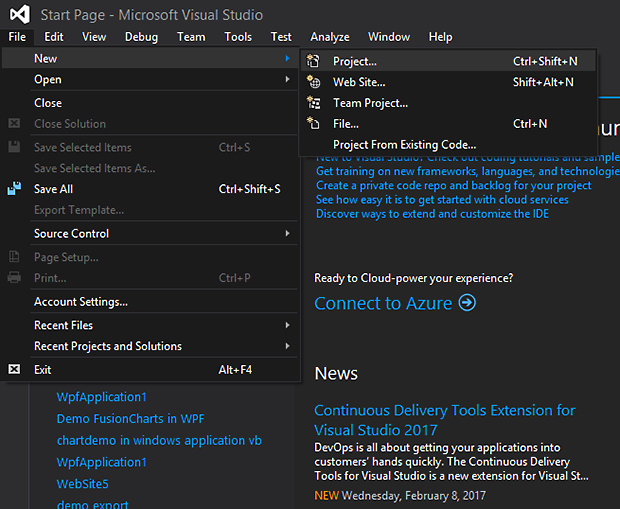
Creating New Project
Step 2: Select Visual Basic from the installed templates. Select ASP.NET application as shown in the image below: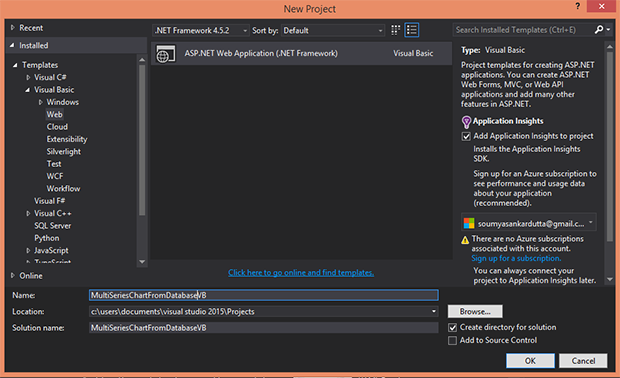
Select ASP.NET Web Application as Project Type
Step 3: Create a project hierarchy named MultiSeriesChartFromDatabaseFromVB. Refer to the image below:
Project Hierarchy
Creating a Database
Here we’ll create a multi-series column chart using data from the database. The chart will showcase a comparison between the factories’ output w.r.t quality. Following are the steps to create a multi-series column chart in VB.NET. Step 1: Create a database (the name of the database is FactoryDb in our case) with two tables that showcase the date-wise production output of three different factories. The image below shows the schema diagram for the table:
Schema Diagram for the Database
Step 2: Add the App_Data ASP.NET folder into the created project. Click (right-click) Project_Name -> Select Add Click Add ASP.NET Folder option -> Select App_Data Refer to the image below:
Adding the App_Data ASP.NET Folder
Establish Database Connection
To hold the connection property in a centralized location, the connection properties should be defined using <connectionStrings> tag in the web.config file. Web.config file is by default created within the project for holding the configurations of web applications. Follow the steps below to define the connection property in web.config file:- Open Web.config file and locate <configuration> tag
- Add <connectionStrings> tag after <configuration> tag
- Define <connectionStrings> as shown below:
<add name="MSAccessConnection" connectionString="Provider=Microsoft.Jet.OLEDB.4.0; Data Source=|DataDirectory|FactoryDB.mdb" providerName="System.Data.OleDb"></add> - Save the Web.config file
Add an .aspx File for Creating Charts
Step 1: Add a folder named scripts inside the project and include all the FusionCharts js files into the scripts folder. The folder structure of the project is shown in the image below: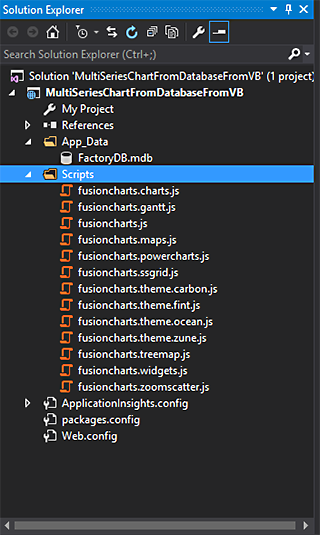
Add scripts folder
Step 2: Add FusionCharts.dll (as a reference) into the project to use FusionCharts VB.NET wrapper. To add FusionCharts.dll as a reference:- Right-click on References->Select Add References. Refer to the image below:

Add Reference to the project
- Selecting Add Reference in the above step will open a Reference Manager dialogue box. Search for FusionCharts.dll in your local machine and add it to this box. Refer to the image below:
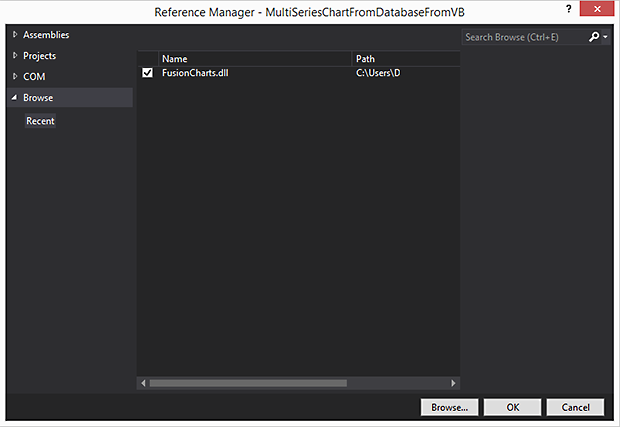
Add FusionCharts reference within the Project
Step 3: Add a new file (.aspx) named “Multiseriesdemo” within the project hierarchy. Step 4: Include the fusioncharts.js and fusioncharts.charts.js libraries within <head> tag of Multiseriesdemo.aspx file as shown below:<script type="text/javascript" src="scripts/fusioncharts.js"></script><asp:literal ID="Literal1" runat="server"></asp:literal>- Imports System.Data.Odbc
- Imports FusionCharts.Charts
- Imports System.Data.OleDb
- Imports System.Configuration
Public Class DbConn
' Create a database Connection. using here Access Database
' Return type object of OdbcConnection
Public connection As OleDbConnection
Public ReadData As OleDbDataReader
Public aCommand As OleDbCommand
Public Sub New(strQuery As String)
' MS Access DataBase Connection - Defined in Web.Config
Dim connectionName As String = "MSAccessConnection"
' SQL Server DataBase Connection - Defined in Web.Config
'string connectionName = "SQLServerConnection";
' Creating Connection string using web.config connection string
Dim ConnectionString As String = ConfigurationManager.ConnectionStrings(connectionName).ConnectionString
Try
' create connection object
connection = New OleDbConnection()
' set connection string
connection.ConnectionString = ConnectionString
' open connection
connection.Open()
' get reader
GetReader(strQuery)
Catch e As Exception
HttpContext.Current.Response.Write(e.Message.ToString())
End Try
End Sub
' Create an instance dataReader
' Return type object of OdbcDataReader
'''
''' Get Data Reader
'''' Create the `jsonData` StringBuilder object to store the data fetched
'from the database as a string.
Dim jsonData As New StringBuilder()
Dim ReqDatasetComma As Boolean = False, ReqComma As Boolean = False
' Initialize the chart-level attributes and append them to the
'`jsonData` StringBuilder object.
' add chart level attrubutes
jsonData.Append("{" + "'chart': {" + "'caption': 'Factory Output report'," + "'subCaption': 'By Quantity'," + "'formatNumberScale': '0'," + "'rotatelabels': '1'," + "'showvalues': '0'," + "'showBorder': '1'" + "},")
' Initialize the Categories object.
jsonData.Append("'categories': [" + "{" + "'category': [")
' Every date between January 01, 2003 and January 20, 2003 is entered thrice
' in the datepro field in the FactoryDB database.
' The dates will be shown as category labels on the x-axis of the chart.
' Because we need to show each date only once, use the `select` query
' with the `distinct` keyword to fetch only one instance of each date from the database.
' Store the output of the `select` query in the `factoryQuery` string variable.
Dim factoryQuery As String = "select distinct format(datepro,'dd/mm/yyyy') as dd from factory_output"
' Establish the database connection.
Dim oRs As New DbConn(factoryQuery)
' Iterate through the data in the `factoryQuery` variable and add the dates as
' labels to the category object.
' Append this data to the `jsonData` object.
While oRs.ReadData.Read()
If ReqComma Then
jsonData.Append(",")
Else
ReqComma = True
End If
' category level attributes
jsonData.AppendFormat("{{" + "'label': '{0}'" + "}}", oRs.ReadData("dd").ToString())
End While
'Close the database connection.
oRs.ReadData.Close()
'Close the catgories object.
jsonData.Append("]" + "}" + "],")
' Initialize the Dataset object.
jsonData.Append("'dataset': [")
'Fetch all details for the three factories from the Factory_Master table
' and store the result in the `factoryquery2` variable.
Dim factoryquery2 As String = "select * from factory_master"
'Establish the database connection.
Dim oRs1 As New DbConn(factoryquery2)
' Iterate through the results in the `factoryquery2` variable to fetch the
' factory name and factory id.
While oRs1.ReadData.Read()
If ReqDatasetComma Then
jsonData.Append(",")
Else
ReqDatasetComma = True
End If
' Append the factory name as the value for the `seriesName` attribute.
' dataset level attributes
jsonData.AppendFormat("{{" + "'seriesname': '{0}'," + "'data': [", oRs1.ReadData("factoryname").ToString())
' Based on the factory id, fetch the quantity produced by each factory on each day
' from the factory_output table.
' Store the results in the `factoryquery3` string object.
Dim factoryquery3 As String = "select quantity from factory_output where factoryid=" + oRs1.ReadData("factoryid").ToString()
'Establish the database connection.
Dim oRs2 As New DbConn(factoryquery3)
ReqComma = False
' Iterate through the results in the `factoryquery3` object and fetch the quantity details
' for each factory.
' Append the quantity details as the the value for the `` element.
While oRs2.ReadData.Read()
If ReqComma Then
jsonData.Append(",")
Else
ReqComma = True
End If
' data set attributes
jsonData.AppendFormat("{{" + "'value': '{0}'" + "}}", oRs2.ReadData(0).ToString())
End While
' Close the database connection.
oRs2.ReadData.Close()
' Close individual dataset object.
jsonData.Append("]" + "}")
End While
' Close the database connection.
oRs1.ReadData.Close()
' Close the JSON object.
jsonData.Append("]" + "}")
' Initialize chart - MSLine Chart data pulling from database
Dim factoryOutput As New Chart("mscolumn2d", "myChart", "600", "350", "json", jsonData.ToString())
' Render the chart
Literal1.Text = factoryOutput.Render()

Start Page option
Step 10: Now, you are ready to render FusionCharts in your visual basic. Press ctrl + f5 to run and check the output of the chart as shown in the image below: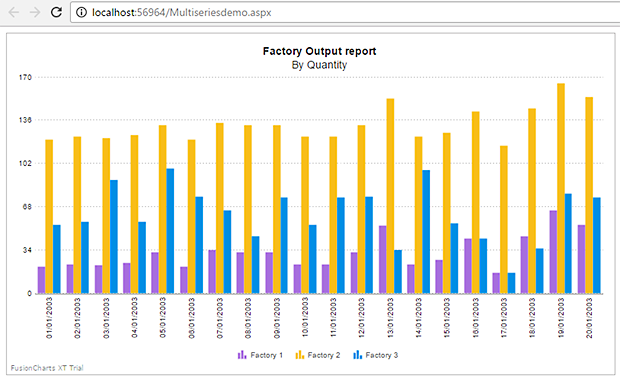
Multi-Series Column 2D Chart
If you find any difficulty in rendering the chart or you see any error in your code, not to worry! Please click here to download the complete source code of the sample project we have created for this tutorial.
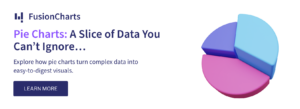
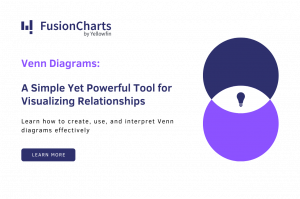

giasudaiviet.com
July 21, 2017, 5:32 pmI’ve learn some excellent stuff here. Certainly price bookmarking for revisiting.
I wonder how so much attempt you set to create this kind of great informative
web site.
backlink.edu.vn
July 23, 2017, 2:15 pmAmazing blog! Do you have any recommendations for aspiring writers?
I’m hoping to start my own site soon but I’m a little lost on everything.
Would you advise starting with a free platform like
Wordpress or go for a paid option? There are so many choices out there that I’m completely confused ..
Any tips? Kudos!